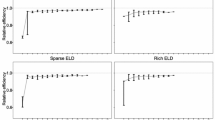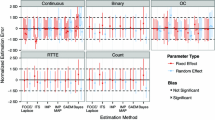Abstract
This paper describes an approach for optimising sampling windows for population pharmacokinetic experiments. Sampling windows designs are more practical in late phase drug development where patients are enrolled in many centres and in out-patient clinic settings. Collection of samples under the uncontrolled environment at these centres at fixed times may be problematic and can result in uninformative data. Population pharmacokinetic sampling windows design provides an opportunity to control when samples are collected by allowing some flexibility and yet provide satisfactory parameter estimation. This approach uses information obtained from previous experiments about the model and parameter estimates to optimise sampling windows for population pharmacokinetic experiments within a space of admissible sampling windows sequences. The optimisation is based on a continuous design and in addition to sampling windows the structure of the population design in terms of the proportion of subjects in elementary designs, number of elementary designs in the population design and number of sampling windows per elementary design is also optimised. The results obtained showed that optimal sampling windows designs obtained using this approach are very efficient for estimating population PK parameters and provide greater flexibility in terms of when samples are collected. The results obtained also showed that the generalized equivalence theorem holds for this approach.
Similar content being viewed by others
References
Ritschel WA, Kearns GL (1998) Handbook of basic pharmacokinetics. American Pharmaceutical Association, Washington
Aarons L (1991) Population pharmacokinetics: theory and practice. Br J Clin Pharmacol 32: 669–670
Endrenyi L (1981) Design of experiments for estimating enzyme and pharmacokinetic parameters in kinetic data analysis. In: Endrenyi L (eds) Design and analysis of enzyme and pharmacokinetic experiments. Plenum Press, New York, pp 121–167
al Banna MK, Kelman AW, Whiting B (1990) Experimental design and efficient parameter estimation in population pharmacokinetics. J Pharmacokinet Biopharm 18: 347–360 doi:10.1007/BF01062273
Retout S, Mentré F, (2003) Optimization of individual and population designs using Splus. J Pharmacokinet Pharmacodyn 30: 417–443 doi:10.1023/B:JOPA.0000013000.59346.9a
Gagnon R, Leonov S (2005) Optimal population designs for PK models with serial sampling. J Biopharm Stat 15: 143–163 doi:10.1081/BIP-200040853
Mentré F, Mallet A, Baccar D (1997) Optimal design in random-effects regression models. Biometrika 84: 429–442 doi:10.1093/biomet/84.2.429
Aarons L, Balant LP, Mentré F, Morselli PL, Rowland M, Steimer JL, Vozeh S (1996) Practical experience and issues in designing and performing population Pharmacokinetic/Pharmacodynamic studies. Eur J Clin Pharmacol 49: 251–254
Jonsson EN, Wade JR, Karlsson MO (1996) Comparison of some practical sampling strategies for population pharmacokinetic studies. J Pharmacokinet Biopharm 24: 245–263 doi:10.1007/BF02353491
Hashimoto Y, Sheiner LB (1991) Designs for population pharmacodynamics: value of pharmacokinetic data and population analysis. J Pharmacokinet Biopharm 19: 333–353
Green B, Duffull SB (2003) Prospective evaluation of a D-optimal designed population pharmacokinetic study. J Pharmacokinet Pharmacodyn 30: 145–161 doi:10.1023/A:1024467714170
Graham G, Aarons L (2006) Optimal blood sampling time windows for parameter estimation in population pharmacokinetic experiments. Stat Med 25: 4004–4019 doi:10.1002/sim.2512
Patan M, Bogacka B (2007) Efficient sampling windows for parameter estimation in mixed-effects models. mODa 8—advances in model-oriented design and analysis. Physica-Verlag, HD, pp 147–155
Duffull S, Graham G, Mengersen K (2006) Bayesian estimation of optimal sampling times for pharmacokinetic models. 15 (Abstr 943). http://www.page-meeting.org/?abstract=943
Fedorov VV, Hackl P (1997) Model-oriented design of experiments. Springer-Verlag, New-York
Fedorov VV, Gagnon R, Leonov S, Wu Y (2007) Optimal design of experiments in pharmaceutical applications. In: Dmitrienko A, Chuang-Stein C, D’Agostino R (eds) Pharmaceutical statistics using SAS, a practical guide. SAS Institute Inc., Cary, pp 151–193
Retout S, Comets E, Samson A, Mentré F (2007) Design in nonlinear mixed effects models: optimization using the Fedorov-Wynn algorithm and power of the Wald test for binary covariates. Stat Med 26: 5162–5179 doi:10.1002/sim.2910
Ogungbenro K, Graham G, Gueorguieva I, Aarons L (2008) Incorporating correlation in interindividual variability for the optimal design of multiresponse pharmacokinetic experiments. J Biopharm Stat 18: 342–358 doi:10.1080/10543400701697208
Stein M (1987) Large sample properties of simulations using latin hypercube sampling. Technometrics 29: 143–151 doi:10.2307/1269769
Kiefer J, Wolfowitz J (1960) The equivalence of two extremum problems. Can J Math 12: 363–366
Kiefer J (1974) General equivalence theory for optimum designs (approximate theory). Ann Stat 2: 849–879 doi:10.1214/aos/1176342810
Duffull S, Waterhouse T, Eccleston J (2005) Some considerations on the design of population pharmacokinetic studies. J Pharmacokinet Pharmacodyn 32: 441–457 doi:10.1007/s10928-005-0034-2
Atkinson AC, Bogacka B (1997) Compound D- and D-s-optimum designs for determining the order of a chemical reaction. Technometrics 39: 347–356 doi:10.2307/1271499
Cook RD, Wong WK (1994) On the equivalence of constrained and compound optimal designs. J Am Stat Assoc 89: 687–692 doi:10.2307/2290872
Ogungbenro K, Gueorguieva I, Majid O, Graham G, Aarons L (2007) Optimal design for multiresponse pharmacokinetic-pharmacodynamic models: dealing with unbalanced designs. J Pharmacokinet Pharmacodyn 34: 313–331 doi:10.1007/s10928-006-9048-7
Author information
Authors and Affiliations
Corresponding author
Rights and permissions
About this article
Cite this article
Ogungbenro, K., Aarons, L. Optimisation of sampling windows design for population pharmacokinetic experiments. J Pharmacokinet Pharmacodyn 35, 465–482 (2008). https://doi.org/10.1007/s10928-008-9097-1
Received:
Accepted:
Published:
Issue Date:
DOI: https://doi.org/10.1007/s10928-008-9097-1




